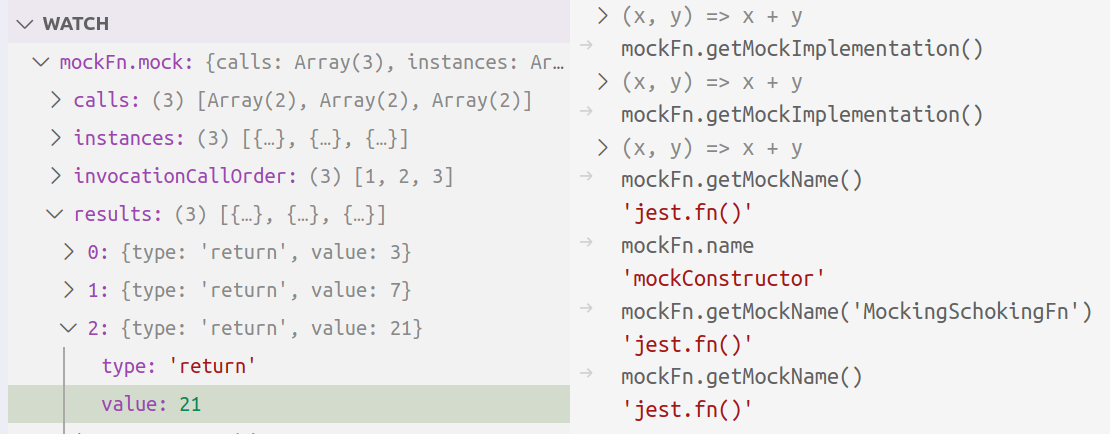Tests are lifeline for your code. A dirty code could always be refactored, but a broken code could not.
# ✅ Javascript Testing
- Mocking
Object faking - Test Stubs are mocks that helps you test. For Example, interface for
sendEmail - mock objects are objects where you actually put asserts on test to determine test pass/fail status. For Example, test if
sendEmailservice wrote a success/failure log. We will mocklogWriterin this scenario. - TDD forces you to think about writing testable code under various conditions
# 🐒 Why Mocking
- Goal of mocking to avoid using any external service. Why would we want to do that?
- to make tests run faster
- to make tests more isolated
- to make tests more independent and idempotent of each other
- great for writing unittests
- If our tests depends on some external service, then we might better call it integration test
- Great of simulating scenarious like
- What if database is empty?
- what if databse is full?
- what if delays are
sec? *what if network is super slow? Or no network at all situation.
# 🎎 Mock Object
- Track function calls, #instances created, results returned etc.
- Erase the actual implementation of a function
- what to assert on? values?
expect(value).toMatchSnapshot()

let car = 'some cat'
console.log(car);
/** REVIEW
*
* The jest object is automatically in scope within every test file.
* The methods in the jest object help create mocks.
* imported explicitly by via
* import {jest} from '@jest/globals'.
*
* NOTE -> MOCKING aka Spying
* 1. How the method was called
* 2. What were the responses to each call
*
* https://jestjs.io/docs/en/mock-function-api#methods
* https://jestjs.io/docs/en/jest-object#mock-functions
* https://stackoverflow.com/questions/2665812/what-is-mocking
*
* How to create mock objects/functions?
* 1. jest.fn(implementation)
* 2. jest.spyOn(object, methodName)
*
* How to create test stubs? Indirections?
* https://jestjs.io/docs/en/manual-mocks#mocking-user-modules
*
* NOTE -> Parameterized and concurrent tests
* test.only
* test.each(table)(name, fn, timeout)
* test.todo(name)
*/
const timeout = 5000;
// beforeAll(SuiteSetup, timeout)
// beforeEach(TestSetup, timeout)
// afterEach(TestTeardown, timeout)
// afterAll(SuiteTeardown, timeout)
function sumFn (a, b) {
return (a+b)
}
describe('dummy test suite', () => {
test('both integer argumants', () => {
// Mock sumFn Functionality
const mockFn = jest.fn((x, y) => x+y);
console.log(mockFn);
// expect(actual).toBe(6)
})
})# ⏲ Timer Functions
The native timer functions (i.e., setTimeout, setInterval, clearTimeout, clearInterval)
are less than ideal for a testing environment since they depend on real time to elapse.
jest.useFakeTimers();
// Fast-forward until all timers have been executed
jest.advanceTimersByTime(1000);
jest.clearAllTimers()
Enable fake timers by calling jest.useFakeTimers();.
This mocks out setTimeout and other timer functions with mock functions.
If running multiple tests inside of one file or describe block, jest.useFakeTimers();
can be called before each test manually or with a setup function such as beforeEach.
- Callback is called after 1 second?
# 🌧 Good Questions
- What should I test in a component?
what/how to test.
- HTML structure?
- CSS classes?
- View logic?
- Event Handlers?
- Lifecycle hooks?
- Methods, computed properties?
- Am I going for 100% coverage?
- Unit | Integration | e2e test?
- Use testing stub boilerplates snippets. saves time
- What is the difference b/w jest.fn() and jest.spyOn()? (opens new window)
They both does the same job but in different ways.
spyOn- lets us create a mock from and existing class/method which we want to use in our testjest.fn()- lets us create mock object from scratch. Usually we just plug in the return values without caring about the implementation.- Difference between
jest.fn()andjest.mock()? jest description jest.fn() (opens new window) mocks objects and functions jest.mock() (opens new window) mocks a module - How to mock JSON imports?
Use moduleNameMapper (opens new window) in settings to mock a json file import.